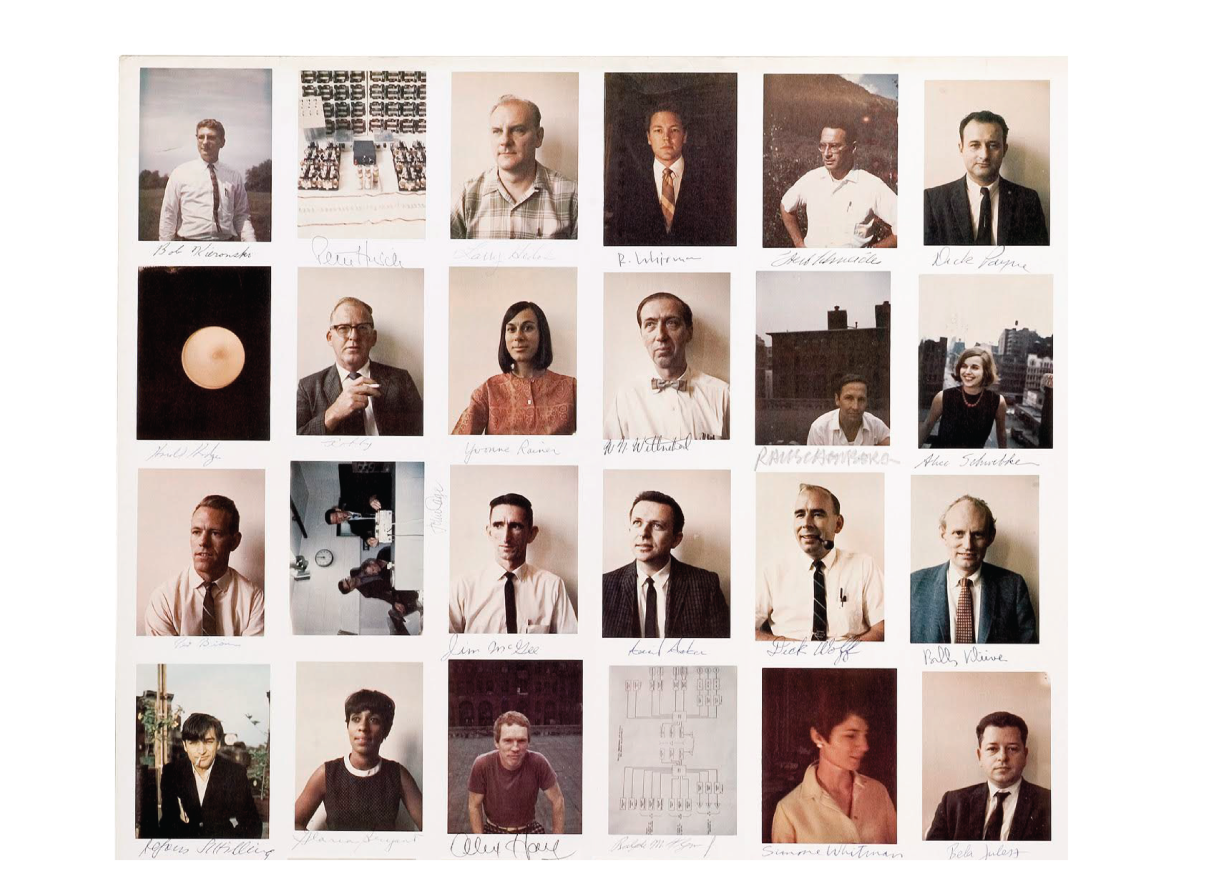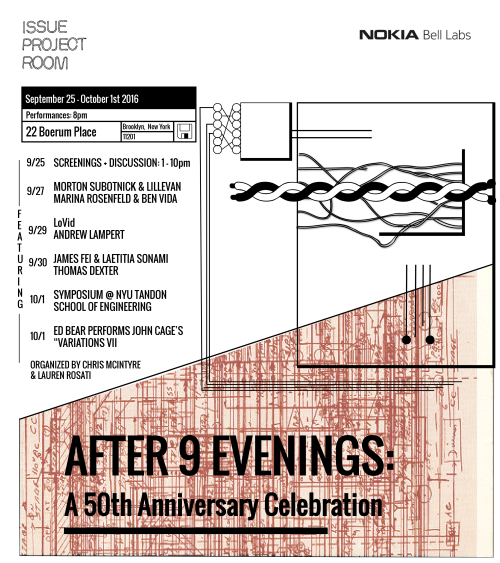In October 1966, Experiments in Art and Technology (E.A.T.) produced a series of legendary performances, 9 Evenings: Theatre & Engineering, at the 69th Regiment Armory in New York City. Artists including John Cage, Yvonne Rainer, and David Tudor in collaboration with engineers and scientists from Bell Telephone Laboratories developed innovative performances combining dance, music, and theater with new technologies. The films of each performance, produced by Billy Klüver and Julie Martin for E.A.T., are rarely-seen archival documents that reconstruct this historic event.
On Sunday, September 25 ISSUE, in association with Julie Martin, presents ten rarely-seen films of the original “9 Evenings” performances at ISSUE’s 22 Boerum Place theater. An open screening, the film program runs throughout the evening and features archival footage of Alex Hay, Steve Paxton, Yvonne Rainer, Deborah Hay, Robert Whitman, Lucinda Childs, John Cage, David Tudor, Öyvind Fahlström, and Robert Rauschenberg. The screening is followed by a panel discussion featuring R. Luke DuBois, composer and engineer; Robert Kieronski, Bell Labs engineer in “9 Evenings”; Michelle Kuo, editor-in-chief of Artforum and an expert on E.A.T.; Julie Martin, 9 Evenings participant; and Alessandra Nicifero, dance critic. The screening takes place from 1-8pm; the panel begins at 8pm. A short reception follows.
FILM SCREENINGS
1pm – 8:00pm
1:00pm – Alex Hay
1:45pm – Steve Paxton
2:30pm – Yvonne Rainer
3:15pm – Deborah Hay
4:00pm – Robert Whitman
4:45pm – Lucinda Childs
5:30pm – John Cage
6:15pm – Robert Rauschenberg
7:00pm – David Tudor
DISCUSSION
8 – 9:15pm
R. Luke DuBois
Robert Kieronski
Michelle Kuo
Julie Martin
Alessandra Nicifero
RECEPTION
9pm – 10:30pm
With screening of Öyvind Fahlström’s performance
ALEX HAY: Grass Field. Alex Hay wore a backpack of specially designed differential amplifiers and FM transmitters that picked up brain waves, muscle activity, and eye movement from electrodes placed on his head and body. These sounds were broadcast to the audience as Alex carefully laid out 64 numbered pieces of cloth. Then, as he sat facing the audience, his face was projected on a large screen behind him while two performers systematically picked up the pieces of cloth.
STEVE PAXTON: Physical Things. A polyethylene air-inflated structure occupied most of the Armory floor. The audience could walk through the structure freely, encountering projections, sounds, and performers. Outside the structure, wire loops suspended above the audience generated sounds of music, screaming jungle birds, men discoursing on fishing, etc., that the audience heard through small pick-up devices, designed and built by the engineers especially for this performance.
YVONNE RAINER: Carriage Discreteness. Spread out on the floor were cubes, planks, sheets, and beams of different materials: Masonite, wood, styrofoam, rubber, etc. Seated in a high balcony, Rainer transmitted instructions to the performers to carry objects from one place to another, using FM transmitter and pickups. Simultaneously, events preprogrammed on ACTAN drum switches took place, including film and slide projections, foam rubber dropping from the ceiling, and a collapsing screen.
DEBORAH HAY: Solo. Hay’s contribution was a tightly choreographed dance for dancers and carts. Eight formally dressed seated players controlled the movement of the carts. The dancers entered either walking or riding on a cart, and then walked or rode on the carts in solo, duet, or trio formations. The whole space was filled with changing patterns of dancers, carts, light and sound. The remotely radio-controlled carts were designed and built by the participating engineers.
ROBERT WHITMAN: Two Holes of Water - 3. Seven cars, carrying film and television projectors, drove out onto the Armory floor and parked facing the back wall, which was covered with white paper. On the balcony, television cameras shot performances: two girls moving slowly in front of a curved mirror, a girl typing, a small fiber optic camera inside a coat pocket. Whitman fed images of these live performances and off-air television images to the television projectors in the cars. He also cued the drivers to turn on the films of nature subjects he had made earlier.
LUCINDA CHILDS: Vehicle. A 70 kHz Doppler sonar system, specially designed for this piece, was activated by three red fireman's buckets that Childs took from a performer in a Ground Effects Machine and hung from scaffolding. As she swung the buckets around inside the ultrasonic sound beams, the reflected signals from the buckets mixed with the original 70 kHz signal, and the resulting frequency fell in the audible range. These sounds were transmitted to the twelve speakers around the Armory.
JOHN CAGE: Variations VII. Thirty photocells were mounted at ankle level around the performance area. They activated a variety of sound sources as the performers moved around. These sources were from contact microphones placed on a blender, juicer, fan, toaster, twenty radio channels, and two Geiger counters. In addition, Cage had ten open phone lines to places in New York City like the restaurant Luchows, the Aviary, the 14th Street Con Edison electric power station, and engineer Billy Klüver’s turtle tank.
ROBERT RAUSCHENBERG: Open Score. The first part was a tennis match. A specially-built FM radio transmitter fit in the handle of each racquet. Each time the ball hit the strings of the racquet, a contact microphone picked up the sound, which was amplified and heard through the twelve speakers around the Armory; one stage light went out. When the area was completely dark, a crowd of 300 people entered. Infrared television cameras picked up the group's movements and projected these images to three large screens seen by the audience.
DAVID TUDOR: Bandoneon! As Tudor played the bandoneon, ten contact microphones picked up the sound that was then distributed to four processing devices. The output of a forty-channel filter was fed to twelve speakers, and controlled the spotlights on the balcony. An audio processing and modifying circuit built by Tudor fed four transducers and horn speakers on the Armory floor. A proportional control system also fed into the twelve speakers. The fourth device, designed by Lowell Cross, controlled images on three television projectors.
ÖYVIND FAHLSTRÖM: Kisses Sweeter than Wine. This was a complex poetic theater performance incorporating live actors, elaborate props, slides, and film and television projections. Some of the characters and images were Jedadiah Buxton, an idiot Savant who could multiply large numbers in his head; Space Girl, dressed in silver, who descended in a winch hoist from the ceiling; a girl in a plastic swimming pool of Jello, and a remote-controlled Mylar inflated missile circling the Armory.
R. Luke DuBois is a composer, artist, software engineer, and performer who explores the temporal, verbal, and visual structures of cultural and personal ephemera. He holds a doctorate in music composition from Columbia University, and has lectured and taught worldwide on interactive sound and video performance. He is also the director of the Brooklyn Experimental Media Center at the NYU Tandon School of Engineering.
Robert Kieronski is an electrical engineer who has worked on nuclear submarines, analog music synthesizers, and integrative circuits. As an employee of Bell Telephone Laboratories (1963 to 1969), he developed the Vochrome, a sound analysis instrument used by David Tudor in “9 Evenings: Theatre and Engineering” (1966).
Michelle Kuo is the editor-in-chief of Artforum International and a doctoral candidate at Harvard University in the History of Art and Architecture, writing a dissertation titled: “‘To Avoid the Waste of a Cultural Revolution’: Experiments in Art and Technology (E.A.T.), 1966-1979.”
Julie Martin has been an active figure in the New York art community since the 1960s. She collaborated with Robert Whitman and other artists on the now legendary performance series “9 Evenings: Theatre and Engineering” and was an early member of Experiments in Art and Technology, founded by her husband, Billy Klüver, and the artist Robert Rauschenberg. She continues to document the history of E.A.T. and recently produced a series of films on artists’ performances from “9 Evenings.”
Alessandra Nicifero is a translator and dance critic. She recently completed a monograph on Bill T. Jones and is conducting interviews with “9 Evenings” participants for the Robert Rauschenberg Oral History Project. She serves on the editorial board of the Dance Research Journal.


